Electric Vehicles – driving through the barriers
Enabling efficient electric vehicle (EV) adoption can provide huge opportunities for improved network utilisation, decarbonisation of transport and integration of renewables.
One of the critical elements for the evaluation of our future network is the efficient capacity utilisation. Efficient capacity can be achieved by 20 per cent adoption of EVs by 2035 with managed charging. This level initially was suggested by the Electricity Network Transformation Roadmap report published in 2017 by Energy Networks Australia in collaboration with the Commonwealth Scientific and Industrial Research Organisation (CSIRO).
Recent modelling undertaken in the Open Energy Networks Project position paper indicated that significant adoption of EVs was likely in the 2030s, resulting in a range of consequences for distribution networks. Because the charging behaviour of EVs is unpredictable, strategies must be developed.
As with any other distributed energy resources (DERs), the efficient management of charging EVs will reduce negative effects on the grid and maximise benefits to consumers and network service providers.
To better understand the impacts and benefits of EV integration, Energy Networks Australia will soon undertake a project through its Australian Strategic Technology Program (ASTP), which is coordinated with the Australian Power Institute (API). The EV Integration Project will be co-funded by Energy Networks Australia and the Centre for New Energy Technologies (C4NET).
The EV Integration Project
This research project aims to:
- explore customer expectations and acceptance for EVs;
- investigate the impacts of unmanaged EVs; and
- investigate how efficient management of charging EVs may mitigate negative impacts.
The project will also explore the techno-economic benefits of EV integration into distribution networks. The University of Melbourne will lead this project in collaboration with Energy Queensland, Endeavour Energy, Jemena, AusNet Services, TasNetworks, Powerlink and CitiPower Powercor.
The project will utilise a range of network-related and consumer-related research methodologies. It will also leverage literature reviews of existing material and overseas experience to inform the long-term scope of work.
The project is expected to provide the following benefits for networks and consumers:
- Networks: The findings from the project are expected to provide vital EV management strategies used to inform future monitoring needs and connection requirements. The output of this project will also inform the design and implementation of future tariff structures.
- Consumers: The findings will assist in educating consumers about EVs and generating more customer-friendly information.
The project will provide further benefits to government, society and the EV industry. These include providing evidence-based input into EV strategies and regulatory assessments. Also, building a common understanding from which government and regulators could have a dialogue with networks around how to increase the uptake while ensuring fairness across the community.
Additional EV Projects Supported by Networks
Several distribution networks have undertaken projects to study the impacts of charging events on the grid, as well as the consumers’ acceptance of EVs.
One such noteworthy project is Charge Together. This Australian Renewable Energy Agency (ARENA)-funded work was led by Evenergi and supported by Ausgrid, SA Power Networks, EV council, Australian EV Association, SA Government, Adelaide Council, NSW Government and NRMA [1] [2] [3].
The project was undertaken in 2018 in two phases. The first phase was understanding behavioural barriers of EV adoption, how EVs would be used, and where they would likely be charged [1]. A report was subsequently published by Evenergi, which outlined the key findings [4].
For customers, it was found that a significant gap exists between the intention and the action of buying an EV. Should these gaps not be addressed, adoption estimates may continue to be overstated. Many consumers focus on the upfront cost, which continues to be a significant barrier to uptake.
Another key finding was that distributed solar would improve payback on a plug-in hybrid electric vehicle by about $1,500 over nine years and up to $4,600 if battery storage was included. This return could result in a correlation between solar panel owners and EVs.
The second phase of the project included the development of an online platform to help customers make informed choices about EVs and assist networks in planning for the potential impacts of EVs [2].
This online tool, ‘BetterFleet’, is designed to help businesses develop detailed business cases for converting existing vehicle fleets to EVs. It also assists fleet managers to produce procurement plans which include economic and environmental assessments of vehicles and charging infrastructure [5].
Phase two work also involved the development of a tool by Ausgrid to help network service providers plan and prepare for the impacts of EV uptake. This included a survey of EV owners in NSW to understand how consumers use and charge their cars [3].
The Key Takeaways
These network-supported projects and future research will help shape the future of EVs in Australia.
What is clear from work so far is that faster uptake of EVs in Australia depends on some key factors.
Customers need to be more comfortable with the technology, networks must better understand the impacts on the grid, vehicle prices need to fall, and their availability needs to increase.
References
| [1] | “SA Strategic Regional Electric Vehicle Adoption Program,” Australian Renewable Energy Agency, [Online]. Available: https://arena.gov.au/projects/south-australian-electric-vehicle-adoption/. |
| [2] | “Charge Together Phase 2,” The Australian Renewable Energy Agency, [Online]. Available: https://arena.gov.au/projects/charge-together-phase-2/. |
| [3] | “Charge Together Project,” Ausgrid, [Online]. Available: https://www.ausgrid.com.au/Industry/Our-Research/DMIA-Research-and-trials/Charge-Together-Project. |
| [4] | “Evenergi,” STRATEGIC REGIONAL ELECTRIC VEHICLE ADOPTION PROGRAM, [Online]. Available: https://c64f6d2e-f6f8-4643-8523-f65a5b16961d.filesusr.com/ugd/b76440_840bfccb2e8445899ebdd5eb974de0b7.pdf?index=true. |
| [5] | “Helping fleets to switch to electric vehicles,” ARENA, [Online]. Available: https://arena.gov.au/news/helping-fleets-to-switch-to-electric-vehicles/. |

